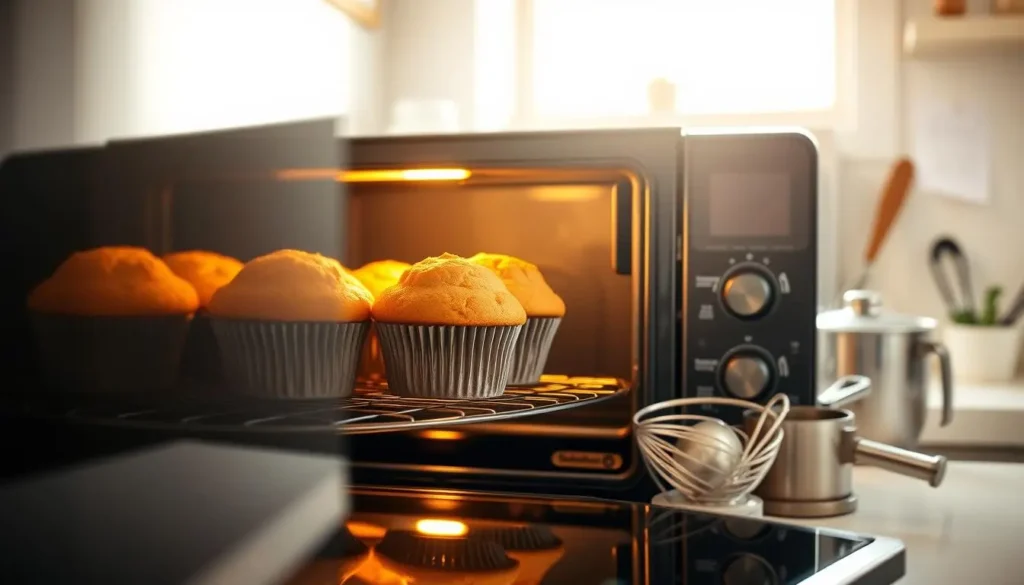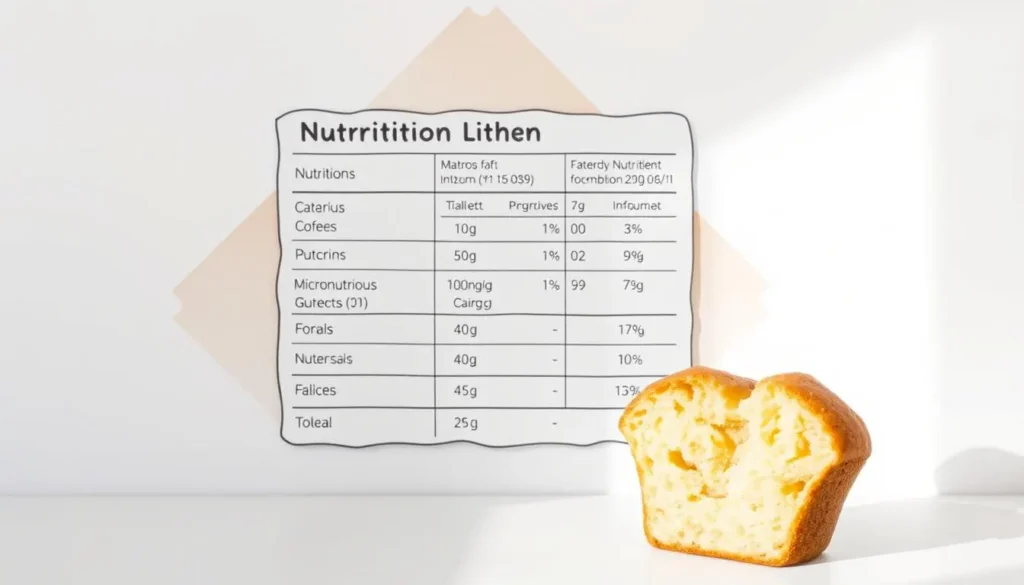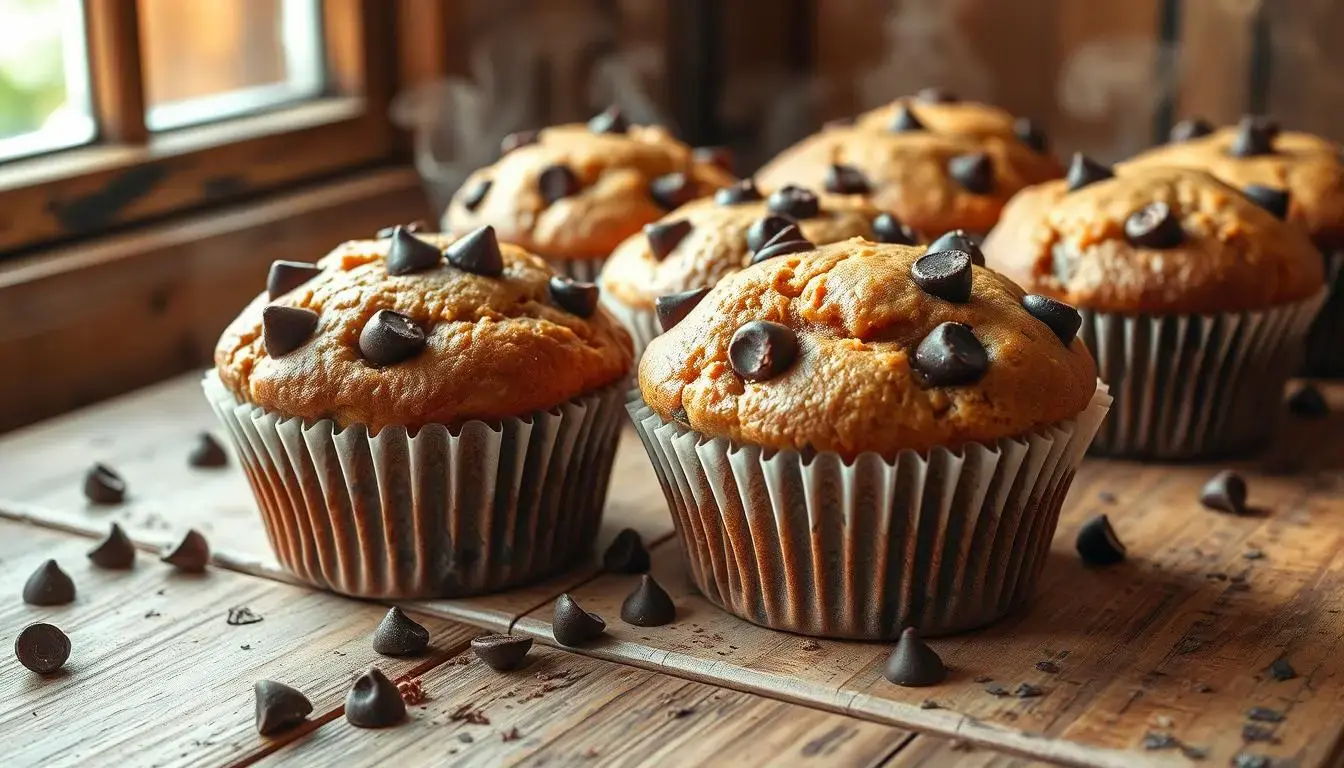Protein Muffins: Easy Homemade Recipe for a Nutritious Snack
Imagine biting into a warm, fluffy muffin that not only satisfies your sweet tooth but also fuels your body with lasting energy. That’s the magic of homemade protein muffins—a nutritious snack that tastes indulgent but supports your health goals. These healthy protein muffins are perfect for busy mornings or post-workout recovery—packed with wholesome ingredients and lasting energy.
Unlike store-bought options that often hide added sugars or artificial ingredients, these muffins are made with simple pantry staples like oats, eggs, and protein powder. In less than 30 minutes, you’ll have moist, bakery-style muffins that are perfect for post-workout recovery, a quick breakfast, or an afternoon pick-me-up.
Best of all, protein muffins are customizable—fold in chocolate chips for a treat, fresh berries for antioxidants, or nuts for crunch. Whether you crave something classic or indulgent, these chocolate chip protein muffins strike the perfect balance between sweetness and nutrition. With each serving delivering about 20 grams of protein, they’re proof that wholesome and delicious can go hand in hand.
Table of Contents
Introduction to Homemade Protein Muffins
Taking control of your snacks starts with knowing exactly what goes into them. When you bake at home, every ingredient gets a purpose—no hidden sugars or mystery additives. This method helps you create treats that align with your nutrition goals while still curbing cravings.
Discover the Benefits of Baking at Home
Your kitchen becomes a lab for flavor experiments. Swap processed store-bought options for fresh creations like healthy protein muffins made with oats, almond flour, and natural sweeteners. Three reasons to start mixing:
- Adjust sweetness with natural options like mashed bananas
- Boost fiber by adding chia seeds or shredded zucchini
- Preserve freshness without artificial stabilizers
Why You’ll Love This Nutritious Protein-Packed Treat
Adding a scoop of powder transforms ordinary batters into high protein muffins that deliver sustained energy and flavor. A single batch can yield 12 portable snacks, each packing the staying power of a meal replacement bar. Pair dark chocolate chunks with vanilla-flavored base for a dessert-like experience, or fold in blueberries for antioxidant benefits.
Ready to try? protein muffins recipe requires just one bowl and 25 minutes. Start by measuring your dry ingredients: flour, baking soda, and that secret strength-boosting powder. Next, whisk in the wet ingredients such as applesauce or Greek yogurt. Spoon the batter into a lined cupcake tray, then let the oven do the rest.
Essential Ingredients for Protein Muffins
The secret to irresistible, nutrient-packed bites lies in your ingredient choices. These easy protein muffins come together with simple pantry staples, and each component plays a specific role—from creating airy textures to locking in moisture. Let’s break down what makes these treats both delicious and functional.
Understanding the Role of Protein Powder in Muffins
That muscle-fueling powder isn’t just for shakes. It provides structure to baked goods while enhancing their nutritional content. Choose whey or plant-based versions depending on dietary needs—both blend seamlessly into batters when mixed for 2-3 minutes.
- Vanilla or chocolate varieties enhance flavor without added sugar
- Combines with flour to prevent dense results
- Adds 5-7g of sustained energy per serving
Exploring Alternative Ingredients and Natural Sweeteners
Swap traditional flour for almond or oat versions to alter texture. Almond flour provides a nutty, crumbly texture, while whole wheat brings added heartiness. For sweetness, try these swaps:
- Unsweetened applesauce (reduces oil by 50%)
- Mashed bananas or dates for natural sugars
- Greek yogurt to add moisture and tang
At the last step, softly fold dark chocolate chips or chopped nuts into the batter. These add-ins create pockets of flavor without overwhelming the batter. Heads up: overmixing means tough results, so mix just until everything’s barely blended.
Mixing the Batter: Tips and Techniques
The difference between dense and airy lies in how you handle the batter. Mastering proper technique guarantees a well-risen, tender result every time. Let’s dive into methods that guarantee consistent results every time.
Combining Dry and Wet Ingredients Effectively
Start by whisking all dry ingredients—like flour, baking soda, and your chosen powder—in one bowl. In another, blend wet components such as eggs, applesauce, and a splash of vanilla. Pour the wet mix into the dry slowly, stirring just until combined. Overmixing triggers gluten development, which can make the texture tough.
Use a steady hand to beat the batter. Small lumps are okay—they’ll disappear during baking. For balanced sweetness, taste-test before adding extra sugar. A touch of salt enhances the overall flavor without being overwhelming.
Folding in Special Mix-Ins for Extra Protein and Flavor
Add-ins like berries or dark chocolate need gentle handling. Scatter them over the surface, then use a spatula to fold from the bottom up. Three light turns usually do the trick. This method distributes goodies evenly without collapsing air pockets.
Adjust vanilla or sugar levels based on your mix-ins. Tart fruits may need a touch more sweetness, while nuts add natural richness. Work swiftly to maintain the batter’s light and airy texture before baking.
Baking Your Protein Muffins to Perfection
The final step turns your batter into golden, irresistible high protein muffins that look and taste bakery-fresh. Precision here separates good results from bakery-quality outcomes. Let’s ensure every bite meets your expectations.

Setting the Right Oven Temperature and baking Time
Preheat to 375°F—this creates instant lift for your batter, ensuring your protein muffin recipe bakes evenly and stays moist. Most recipes work best within 350-375°F. Too hot? Tops brown before centers cook. Too low? You’ll get dense results.
Gently scoop batter into each muffin cavity, filling them roughly two-thirds full. Bake 15-18 minutes. Check at 12 minutes: edges should pull away slightly. If tops darken too fast, tent with foil.
Ensuring a Moist, Fluffy, and Protein-Rich Texture
Perfect texture starts with smooth batter transfer. Lightly tap the muffin tin against the counter to help any hidden air bubbles escape. This prevents uneven rising.
Insert a toothpick to test; it should emerge with moist crumbs attached. Allow to cool in the pan for 5 minutes, then carefully transfer to a cooling rack. Rushing this step traps steam, making bottoms soggy.
- For hassle-free removal, coat the tin with non-stick spray or insert paper liners.
- Measure leavening agents precisely (1 teaspoon baking soda max)
- Rotate pans halfway for even browning
Creative Protein Muffin Variations and Add-Ins
Transform your baking routine with endless possibilities. A simple base of dry ingredients becomes a canvas for bold combinations. Swap out basic recipes for creations that surprise your taste buds every time.
Enhancing Chocolate Chip Protein Muffins With Nuts and Crunch
Fold in dark chocolate chunks after mixing your batter to create rich, bakery-style chocolate chip protein muffins that still fit your nutrition goals. Their rich melt contrasts beautifully with crunchy walnuts or almonds. Always preheat oven to 375°F first—this ensures even baking around dense add-ins.
Let treats cool completely before serving. This step lets flavors deepen while preventing crumbly textures.Balance sweetness by using semi-sweet chips with unsweetened bases.
Exploring Protein Muffins With Fruit and Spice Combinations
Mashed banana replaces applesauce for tropical vibes. Lightly flour your blueberries before baking—this keeps them evenly distributed and stops sinking. Pumpkin puree adds autumn warmth and moisture.
Adjust dry ingredients slightly when using wetter substitutes. A dash of cinnamon or nutmeg elevates earthy flavor profiles. Always preheat oven and check doneness early—fruit releases extra liquid.
Try adding lemon zest or shredded coconut for a fresh, flavorful twist. Remember: letting batches cool completely ensures clean slicing. Your next favorite flavor might be one daring swap away.
Nutritional Information and Serving Suggestions
Smart snacking starts with knowing what fuels your body. Each bite-sized creation balances taste with functional benefits, giving you clarity about your intake. Let’s break down the numbers and explore ways to integrate these treats into your routine.

Calorie and Protein Breakdown Per Muffin
One freshly baked portion delivers approximately 180 calories and 20 grams of muscle-supporting fuel. Each serving contains about 15 grams of carbs, mostly from whole-grain oats. Eggs do double duty—contributing 6 grams of complete protein and helping bind the batter for a soft, springy texture.
Using a standard bowl mix, you’ll get consistent results across all 12 slots in your tin. Swap ingredients? Recalculate: Using almond flour cuts the carbs by about 20%, while vegan egg alternatives slightly reduce the overall protein content.
Protein Muffins and Meal Prep Made Simple
Store cooled batches of these meal prep protein muffins in airtight containers at room temperature for 2 days, or refrigerate for up to 5. For grab-and-go ease, freeze extras layered between parchment paper. Pair a thawed treat with Greek yogurt or apple slices for balanced snacks.
- Portion batter evenly using an ice cream scoop
- Label freezer bags with dates to track freshness
- Reheat in 15-second intervals to retain moisture
Keep your bowl and tin handy—weekly prep sessions become faster with practice. These portable options fit seamlessly into lunchboxes or post-workout routines, proving that smart choices don’t require sacrifice.
Adapting Recipes for Dietary Preferences
Your kitchen becomes a customization playground where dietary needs meet delicious outcomes. Whether avoiding gluten or animal products, simple swaps let everyone enjoy wholesome baked goods without compromise.
Gluten-Free and Vegan Protein Muffin Modifications
Almond flour creates a nutty base that mimics traditional texture while staying grain-free. To replace eggs, mix 1 tablespoon of ground flaxseed with 3 tablespoons of water. Let it sit for 5 minutes to thicken, then stir it into the batter. This “flax egg” adds moisture and a hint of earthiness.
Use liquid sweeteners like maple syrup with care—they can change the texture of your baked goods. Measure precisely using nested containers to maintain balance. Over-pouring can make results gummy. For crunch, fold in dairy-free chips during the final stir to prevent sinking.
- Use sifted coconut flour for lighter crumb structure
- Opt for silicone bakeware to prevent sticking without oils
- Blend wet ingredients 10 seconds longer to emulsify substitutes
Store modified batters in airtight containers if prepping ahead. Stir gently before portioning—alternative flours settle faster. Test doneness early: gluten-free versions bake 2-3 minutes quicker. A toothpick should emerge with tender crumbs, not wet batter.
One tester replaced 25% of flour with pumpkin puree, achieving velvety texture while cutting sugar by 30%. Another swears by mini dark chocolate chips for bursts of flavor that complement nutty bases. With smart mixing and measurement, dietary restrictions become creative opportunities.
Protein Muffins: A Delicious and Nutritious Snack
What if your go-to snack could fuel your day without guilt? These high protein muffins blend pumpkin’s earthy sweetness with the creamy notes of vanilla protein powder, creating a balanced flavor profile that satisfies cravings. Each bite delivers 20 grams of sustained energy—ideal for refueling after exercise or powering through afternoon slumps.
Follow these simple instructions to enjoy them at their best: eat fresh from the oven for a warm, tender crumb, or reheat chilled ones in 15-second microwave bursts. The vanilla protein powder base pairs perfectly with pumpkin puree, adding moisture while keeping sugar content in check.
Why choose these over store-bought options? They skip artificial preservatives and offer customizable nutrition. Busy mornings become effortless when you grab one alongside a piece of fruit or nut butter. Plus, their freezer-friendly nature means you’re never more than two minutes from a wholesome bite.
This recipe plays well with the seasons! Keep vanilla protein powder stocked, then switch pumpkin for mashed sweet potato in winter or stir in citrus zest for summer flair. With clear instructions and minimal prep, these treats prove that smart snacking can be both simple and exciting.
Storage, Freezing, and Reheating Tips
Keep your baked goods tasting fresh-baked days after mixing the batter. Proper storage preserves texture while locking in moisture—critical for maintaining that just-made appeal. Follow these guidelines to enjoy your creations at peak quality, whether you’re grabbing a quick breakfast or planning weekly snacks.
Best Practices for Storage and Room Temperature Conditions
Cool treats completely before sealing them in airtight containers. At room temperature, they’ll stay fresh 2-3 days. For longer freshness, refrigerate in glass containers with parchment layers between layers. Three key strategies:
- Use silicone lids to prevent condensation buildup
- Place a paper towel at the container’s base to absorb excess moisture
- Measure almond flour precisely during prep—proper ratios prevent sogginess
Freezing Guidelines and Reheating Techniques
Freeze extras for up to 6 months using heavy-duty freezer bags. Portion them individually for grab-and-go convenience. To revive frozen batches:
- Microwave 15-20 seconds wrapped in a damp paper towel
- Toast at 300°F for 8–10 minutes until the edges turn crisp.
- Stale baking powder = flat bakes. Check it’s still active before freezing your batter or dough.
Protect add-ins like chocolate chips by cooling treats completely before freezing. For even distribution, mix a cup chocolate chips into batter gently—overmixing causes melting during storage. Always label containers with dates using permanent markers.
Time-Saving Techniques and Meal Prep Ideas
Streamline your mornings with smart kitchen strategies that do the heavy lifting while you sleep. A quality muffin pan becomes your best ally here—its even cavities bake multiple portions uniformly. Prep batter the night before, refrigerate, and bake fresh at dawn for warm, ready-to-go fuel.
Batch Preparation for Quick Breakfasts
Double recipes to fill every slot in your muffin pan. Freeze extras in single-layer stacks for grab-and-go ease. Add a scoop of vanilla protein to the mix—it enhances flavor while keeping energy levels steady. Inspired by banana bread’s moist texture? Fold mashed fruit into the batter for natural sweetness.
Store cooled batches in labeled containers. Pair with hard-boiled eggs or nut butter for balanced meals. Rotate flavors weekly using seasonal add-ins like pumpkin puree or citrus zest.
Utilizing Quick Baking Strategies
Use non-stick spray to guarantee a smooth release from the pan, every single time. For foolproof results:
- Use an ice cream scoop for evenly sized portions of batter.
- Bake at 375°F for consistent rise
- Test doneness when edges come clean from the tin
Revive frozen portions in 20-second microwave bursts. The vanilla protein base pairs perfectly with banana bread-style spices like cinnamon or nutmeg. Always let treats come clean from the cooling rack before storing—this prevents soggy bottoms.
Conclusion
Why settle for store-bought snacks when your oven can craft better? Homemade protein muffins put you in control—transforming simple components like almond flour or mashed banana into nutrient-rich delights. Each batch costs less than premium bars while delivering superior flavor and freshness.
Customization is key. Swap in a cup of chocolate chips for indulgence or adjust wet ingredients like applesauce to lock in moisture, transforming them into chocolate chip protein muffins that satisfy every craving. Need gluten-free options? Almond flour gives your bake a soft, tender crumb without sacrificing structure.
Prepping these treats takes minutes, but the rewards last all week. From high protein muffins for fitness goals to chocolate chip protein muffins for a sweet twist, this versatile protein muffin recipe offers endless flavor possibilities. Share your creations online to inspire others—tag photos of your banana-infused masterpieces or crunchy almond toppings. Ready to redefine snacking? Your kitchen awaits.
FAQ
Can I substitute almond flour with another type?
How do I prevent dry texture in baked goods?
Any tips on how to store these so they stay fresh for meal prep?
Can I make these vegan-friendly?
Why did my batter turn out lumpy?
How can I boost flavor without added sugar?
Is it safe to reheat frozen batches?
Bake It. Love It. Tell Us About It.
There are no reviews yet. Be the first one to write one.

